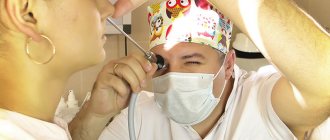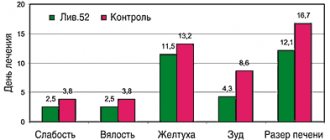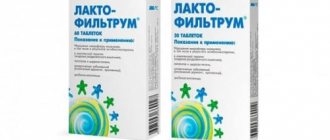Application of new synbiotics in pediatric practice
In contrast to the term “antibiotics”, which denotes drugs that inhibit the growth of bacteria, the name “probiotics” has been proposed - a category of drugs based on living microorganisms that, when administered in adequate quantities, have a positive effect on the health of the host. Such microorganisms are called probiotic [1].
Following this, the terms “prebiotics” and “synbiotics” were introduced. Prebiotics are non-living substances, indigestible by human enzymes, that have a positive physiological effect on the host organism, selectively stimulating the growth or activity of autochthonous intestinal microflora. The term “synbiotics” describes products that contain both probiotics and prebiotics that exhibit synergism.
The normal intestinal flora contains more than 90% obligate anaerobic bacteria (bifidobacteria, eubacteria, bacteroides) and lactobacilli. They are most often used to correct disturbances in the human intestinal microflora, especially in children. Over the course of several decades, in vitro and in vivo, the positive multifaceted influence of normal microbiota of the gastrointestinal tract (GIT) on providing protective, adaptive and metabolic-trophic functions aimed at preserving and maintaining human homeostasis has been established.
In order to restore impaired microflora indicators, they strive to eliminate qualitative and quantitative deviations in the composition and bring them into compliance with the age standards of the industry standard of the Russian Federation [2].
Bifidobacteria are the most significant representatives of intestinal microorganisms in children and adults. In the large intestine they constitute the main populations of parietal and luminal microflora. In children, their content reaches 90–98%, which is no less than 1010–1011 microbial cells per 1 g.
The effectiveness of the use of bifidobacteria in pediatric practice is well known. Currently, at least five of them are actively used as probiotic strains: Bifidobacterium bifidum, B. longum, B. infantis, B. breve, B. adolescentis.
A study of the intestinal microbial landscape showed that the species B. bifidum is present in all healthy people, but is more represented in breastfed infants - up to 70%, in children 4-6 years old - up to 40%, in adults - 1-5- 20%. The species B. longum is also typical for children and adults; it makes up 40–60% of the microbiocenosis of children of the first year, and up to 70–75% in older ages. The species B. adolescentis is characteristic of adults and older children and becomes dominant in older people (up to 85%). B. infantis and B. breve species are found only in infants, with the former reported as the predominant species and B. breve identified as the second most common species [3].
There is a correlative connection between the formation of the intestinal biotope and age-related physiological changes in the body. The formation of microbiocenosis is determined by the presence of dominant species of bifid flora. As a child grows up, some species are replaced by others in the species community of microorganisms due to their bioecological advantages. Children experience a natural sequential change in biocenoses at certain age intervals, due to a number of natural physiological factors.
The biological balance of normal flora is easily disturbed under the influence of a variety of reasons - antibiotic treatment, changes in nutrition, peristalsis, the presence of inflammatory diseases and prolonged dysfunction of the gastrointestinal tract, biliary, enzymatic, endocrine, nervous and other systems and organs.
A team of researchers from MNIIEM named after. G. N. Gabrichevsky was the first in Russian practice to propose dietary supplements-synbiotics created on the basis of consortia of bifidobacteria, taking into account the age-related dominance of individual species.
Based on the joint cultivation of symbiotic associations of high-tech and highly effective species of bifidobacteria (isolated from humans, i.e. species-specific), non-medicinal synbiotic preparations were created on the basis of sustainable consortia separately for children from 0 to 3 years old - Bifidum-Multi-1, children from 3 years old up to 14 - Bifidum-Multi-2 and for teenagers and adults - Bifidum-Multi-3.
According to the age, the Bifidum-Multi-1 consortium contains the species B. infantis, B. breve, B. bifidum, B. longum. Bifidum-Multi-2 includes: B. longum, B. breve, B. bifidum, and Bifidum-Multi-3 consists of B. bifidum, B. longum, B. adolescentis.
In vitro, it was shown that the consortium had antagonistic activity against Shigella sonnei, Sh. flexnery, Escherichia coli, Proteus vulgaris 2–3 times larger than the strains included in it, but grown separately.
The introduction of prebiotics into the formulation was also carried out taking into account age-related characteristics. For the younger age group (Bifidum-Multi-1) - this was maltodextrin recommended by nutritionists for introduction into the diet of young children, and Bifidum-Multi-2 and Bifidum-Multi-3 for children of older age groups and adults are included in the capsule apple pectin, inulin and oligofructose (with increasing dosage as age increases).
Clinical and laboratory observations conducted in newborns and children in the first months of life confirmed the advantage of using Bifidum-Multi-1, developed taking into account the age-related predominance of populations of certain representatives of bifidoflora in infants, compared to taking a single-strain commercial preparation of bifidobacteria [4].
Studies carried out at the Center for Obstetrics and Gynecology of the Russian Academy of Medical Sciences on a contingent of newborns with the threat of intrauterine infection indicated a significantly faster formation of bifido- and lactoflora with a high content (109–1010 and 109, respectively), which occurred on the third day of life. This trend continued further, on days 5–6 at discharge. At the same time, differences were revealed in the rarer colonization of the intestine by hemolysin-producing Escherichia and fecal enterococci, and the lack of growth of cultures of Staphylococcus aureus and Proteus vulgaris. Significant differences were shown for all presented indicators with a single-strain preparation of bifidobacteria in favor of Bifidum-Multi-1, representing a consortium of the species B. infantis, B. breve, B. bifidum, B. longum.
The following work was performed in a children's clinic. The observation included infants in the first months of life, whose mothers noted restlessness of the children, periodic regurgitation and changes in the nature of bowel movements (diarrhea, constipation or intermittent stools), which, however, did not require hospital treatment. During laboratory examination, all children showed a reduced content of bifidobacteria - no more than 8–9 lg CFU/g. Only 25% of the examined children had reference values for lactobacilli. In 30% of children, the total amount of E. coli was reduced. In the group of children who had dyspeptic and intestinal disorders, hemolyzing Escherichia was found with a significantly higher frequency (92.9% versus 42.9%).
After 2–3 weeks of taking Bifidum-Multi-1, a noticeable clinical improvement and disappearance of complaints that were noted on the eve of taking the synbiotic were noted. Bacteriological analysis of stool showed that the number of bifidobacteria reached reference values, the average level of lactobacilli significantly increased, and in children who had a high content of gram-negative enterobacteria and Staphylococcus aureus before taking the drug, microbes were eliminated.
The next series of observations to evaluate the synbiotic Bifidum-Multi-2 was carried out in preschool institutions in Moscow.
Clinical observations of children receiving the synbiotic Bifidum-Multi-2 were carried out by employees of the children's infectious diseases department of MONIKI named after. M. F. Vladimirsky; microbiological studies were carried out in the laboratories of the Moscow Research Institute of Experimental Mathematics. G. N. Gabrichevsky.
The general criteria for inclusion of children in the study were:
- age 4–6 years;
- examination in the pre-epidemic period for the seasonal rise in respiratory morbidity (October-December);
- on the day the study begins: mandatory thermometry, absence of complaints from the child and parents, and upon examination of the oropharynx and skin - no changes;
- daily two-month observation of the child with registration of any, even small, catarrhal manifestations in a specially designed card.
In each team, two groups were formed - those receiving and not receiving synbiotics. The synbiotic was given in a 3-week course (with a 2-day break each week - Saturday, Sunday) twice a day - before breakfast and lunch.
Before the start of the study, all children underwent smears from the mucous membranes of the oropharynx and fecal samples for laboratory analysis.
Repeated analysis of the oropharyngeal smear and stool sample was performed ten days after the probiotic course. The same laboratory study was carried out for children who did not take Bifidum-Multi-2.
When performing a comparative analysis, we took into account the number of days missed due to illness, the complicated course of ARVI, intercurrent diseases, the use of antibacterial agents, and the results of microbiological studies.
In the group of children receiving Bifidum-Multi-2, episodes of acute respiratory infections were noted in 42.8% with an average number of days missed due to illness - 7.3 ± 0.8. There were no complications or intercurrent diseases, and no antibiotic therapy was prescribed. In the comparison group, these values were 61.9% and 16.8 ± 0.7 days, respectively. Along with the noted differences, attention was drawn to such data as the registration of pneumonia (1), otitis media (2), the occurrence of chickenpox (1), and acute intestinal infection (2). Five children in this group were prescribed antibiotics.
In the initial study of the oropharyngeal microbiota, associations of obligate microorganisms of streptococci and neisseria were found in almost all (96% of children), in 9.8% of cases - an increase in the content of Staphylococcus aureus (> 104), in 11.3% enterobacteria were identified. Fungi of the genus Candida were found in one child.
More significant were disturbances in the intestinal microflora, including a decrease in the level of obligate microorganisms: a decrease in the total amount of E. coli - in 17.2%, lactobacilli in 22.5%, bifidobacteria in 6.8%.
In 26.6% of the examined children, E. coli with reduced enzymatic activity was isolated, and in 27.2% - hemolysin-producing. Excessive growth of fungi of the genus Candida was noted in 8.2%; Gram-negative enterobacteria were sown separately or in associations in 11.2% of children.
Statistical analysis of a number of clinical and anamnestic indicators did not reveal a connection between the depth of microbiological changes and the presence of pathology in pregnancy and childbirth in mothers, early neonatal development of the child, and membership in health group III.
Excessive levels of Staphylococcus aureus were more often found in children with established diagnoses of tonsillitis and adenoiditis. However, its etiological significance could not be determined. After taking the synbiotic Bifidum-Multi-2 and restoring the content of obligate microorganisms, the amount of Staphylococcus aureus decreased. This fact casts doubt on the recommendations of a number of researchers about the need to use antibiotics only based on laboratory detection of this microbe.
A comparison of the microbiological disturbances identified in both biotopes also allows us to conclude that each biotope individually has its own changes. No coincidences were found in the frequency of simultaneous detection of certain genera of opportunistic microorganisms - staphylococci, enterobacteria and fungi. At the same time, it was noted that if there was a history of acute respiratory infections within 15–30 days before the study, a sharp decrease in the level of E. coli and lactobacilli was noted. After taking the synbiotic, the level of E. coli increased from lg 6.07 ± 0.17 to lg 8.09 ± 0.11 CFU/g (p < 0.05), and lactobacilli from lg 5.44 ± 0.18 to lg 5 .95 ± 0.14 CFU/g (p < 0.05). In frequently ill children (FIC), dysbiotic disorders were characterized by a significantly higher content (4 times) of gram-negative opportunistic microorganisms (OPM), and in children who had acute respiratory infections during the previous two weeks, microbes of the transient group were significantly more common (p < 0.001 ).
In the microbiota of children after taking Bifidum-Multi-2, positive dynamics of indicators were determined: an increase in the content of bifidobacteria and lactobacilli, the total amount of E. coli also increased to normal in all children. The number of children who isolated hemolysin-producing Escherichia coli decreased by 3 times. Positive changes also included a decrease in the number of children excreting Staphylococcus aureus (from 38.4% to 12.5%) and Enterobacteriaceae (from 30.7% to 12.5%).
Different results were obtained during a microbiological examination of children in the comparison group who did not receive the synbiotic: the content of Staphylococcus aureus in smears from the oropharynx remained the same. The number of children with low levels of complete E. coli in the intestines reached 100%, while the number of hemolysin-producing Escherichia remained high. Fungi of the genus Candida were detected in 30%.
Another synbiotic that was used to correct microflora in children was Normospectrum®.
The peculiarity of the synbiotic Normospectrum® is that it contains a composition of strains of bifidobacteria B. bifidum, B. longum, B. breve, B. infantis and lactobacilli Lactobacillus plantarum, L. acidophilus, L. casei. All strains were isolated from humans and were comprehensively studied. In addition, it contains a vitamin-mineral premix of vitamins E, B1, riboflavin, B6, B12, vitamin C, folic acid, pantothenic acid, niacinamide, biotin, zinc, selenium in the recommended dosage. Normospectrum® includes FOS inulin and oligofructose as prebiotics. A complex of live bifidobacteria and lactobacilli in high concentration eliminates microbial imbalance in the intestines and has high antagonistic activity against pathogenic, opportunistic bacteria and rotaviruses. The strains are resistant to antibiotics, acids, bile, and are selected taking into account the age characteristics of children. The prebiotics included in Normospectrum® ensure enhanced growth of bifidobacteria and lactobacilli.
The theoretical premises underlying the developed synbiotic provide for the correction of disturbed intestinal microflora, which usually arise as a result of acute infections, the course of chronic diseases, the use of antibacterial drugs, and imbalances in the functioning of organs and systems of the macroorganism.
In connection with the above, it was advisable to use it in a contingent of children from the group of frequently ill people with chronic ENT pathology or functional disorders of the digestive system.
Two groups were selected in a preschool institution: those who received and those who did not receive Normospectrum®. From each group, two subgroups were selected from among children classified as CBD, who had chronic tonsillitis, adenoiditis, or functional gastrointestinal disorders.
In the BBD group who received Normospectrum®, the incidence of acute respiratory infections decreased compared to the previous period (from 62.5% to 30%) and remained at the same level in the BBD comparison group (27% and 27%); in the same subgroup, two children developed complications (bronchitis and otitis media), which required the prescription of antibiotics.
It is known that in the pediatric population there is a high proportion of gastroenterological pathology. In those receiving Normospectrum®, the number of dyspeptic disorders decreased (reduction in symptoms of flatulence, rumbling, abdominal pain, intestinal spasms, constipation, “stool”).
The results of a microbiological study after taking Normospectrum® showed an increase in the number of bifidobacteria and lactobacilli in the intestines. This, in turn, had a positive effect on the elimination of Klebsiella, hemolyzing Escherichia and Staphylococcus aureus, which were present during the initial examination on the eve of the appointment. During the initial analysis, transient microorganisms that were not characteristic of this biotope were found on the mucous membranes of the oropharynx in 20% of children. Repeated analysis after taking the drug revealed positive dynamics with a reduction in the number of microorganisms not typical for the biotope against the background of an increased level of obligate microflora associations.
So, the results of a microbiological study of two biotopes of children attending children's institutions showed that after taking synbiotics based on complexes of bifidobacteria that dominate in the bifidobacteria of the intestines of children (Bifidum-Multi-2) or the synbiotic Normospectrum® based on a multiprobiotic complex of bifidobacteria and lactobacilli, physiological for this age group, and the vitamin-mineral premix, representatives of the obligate microflora are restored to normal levels, primarily activating the protective antagonistic function, as a result, the normalized composition of the microbiota triggers a complex of immunological reactions that ensure the formation of the body's resistance.
The use of 2–3-week courses of Bifidum-Multi-1, Bifidum-Multi-2, Normospectrum® had a positive effect on improving clinical and microbiological parameters, and did not reveal side effects or allergization.
Literature
- World Gastroenterology Organisation. 2008, p. 24.
- Industry Standard 91500.11.0004–2003. 2003, p. 70.
- Proceedings of the International Scientific Conference on Probiotics and Prebiotics YPC2010, Kosice, Slovakia, 2010, p. 15.
- Questions of children's dietetics. 2006, vol. 4, no. 6, p. 66–69.
- Kremlin medicine. 2006, No. 3, p. 87.
L. V. Feklisova, Doctor of Medical Sciences, Professor
GU MONIKA named after. M. F. Vladimirsky, Moscow
Contact information about the author for correspondence
Symbiotic FORTE Probiotic+Prebiotic, capsules No. 20
The state of health and psychological comfort of a person directly depends on the functioning of the gastrointestinal tract (GIT), and in particular on the microflora. The beneficial microflora of the gastrointestinal tract includes a wide variety of bacteria, among which the most important are bifidobacteria and lactobacilli.
Synbiotics are a modern group of drugs that contain beneficial microorganisms - probiotics, as well as a nutrient medium for their growth and vital activity - prebiotics.
The complex action of the synbiotic “Symbiotic Forte” stimulates the growth and development of health-promoting bacteria and has a positive effect on overall health.
Bifidobacterium
( Bifidobacterium longum, Bifidobacterium bifidum)
- Helps normalize intestinal microflora and significantly reduce the symptoms of irritable bowel syndrome;
- Improves the absorption of microelements and vitamins;
- They synthesize B vitamins (B1, B2, B6, folic acid), vitamin K; are a “supplier” of a number of essential amino acids, including tryptophan, which contributes to the biosynthesis of serotonin, while ammonia is used as a source of nitrogen;
- They have natural resistance to a number of antibiotics widely used in medical practice, and high antagonistic activity against pathogenic and opportunistic microorganisms.
Lactobacilli
( Lactobacillus lactis, Lactobacillus rhamnosus, Lactobacillus casei)
Take an active part in metabolic processes and correct microecological disorders. They are used to produce probiotics and food products.
- The protective function of bacteria is due to their ability to produce lactic acid. Lactobacilli also synthesize antimicrobial and antibiotic-like substances - lysozyme, hydrogen peroxide, bacteriocins, fatty acids;
- Vitamin-forming function - participation in the synthesis of vitamins B2, B9, B7 and others;
- Lactobacillus activates reduced immunity and does not affect the normally functioning immune system;
- They have the ability to activate the vital processes of bifidobacteria.
Fructooligosaccharides
Fructooligosaccharides are a useful type of prebiotic; indispensable for stimulating the proliferation of beneficial intestinal microflora. The main functions of fructooligosaccharides:
· Stimulation of the growth of normal intestinal microflora (lacto- and bifidobacteria);
· Suppression of the development of pathogenic bacteria;
· Prevention of dysbacteriosis;
· Normalization of intestinal function - improving the digestion and absorption of nutrients, preventing the occurrence and development of putrefactive processes and excessive gas formation in the intestines;
· They are a source of nutrition for epithelial cells of the colon;
· Normalization of stool – increasing the volume of feces, reducing the transit time through the gastrointestinal tract;
· Removing metabolic waste, toxins, cholesterol, heavy metals and radionuclides from the body;
· Increased absorption and absorption of calcium.








